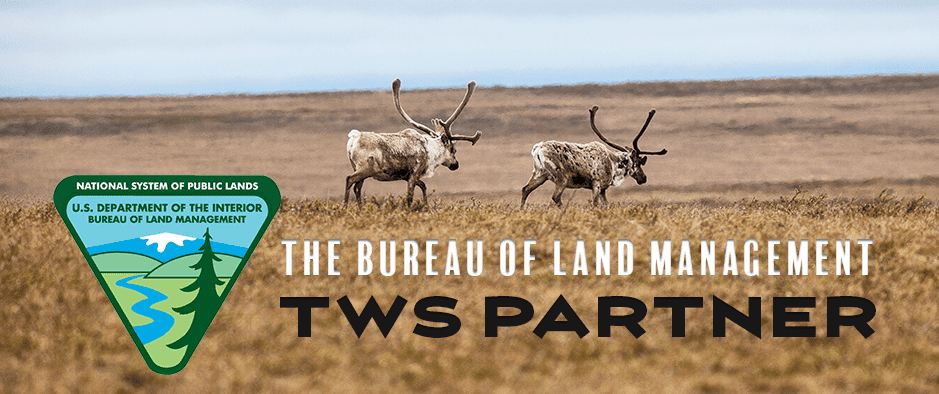Careers | Priorities & TWS | Wildlife Program | Threatened & Endangered Species Program | Program History | Partner Program
CAREERS WITH THE BLM: WILDLIFE BIOLOGISTS
The BLM manages the most land and the largest subsurface mineral estate of any government agency. It carries out a dual mandate under the Federal Land Policy & Management Act (FLPMA): that of managing public land for multiple uses while also conserving natural, historical and cultural resources. In the language of FLPMA, the BLM’s responsibility is to administer public lands “on the basis of multiple use and sustained yield” of resources.
What this means, on a practical level, is that the BLM – except in areas specifically set aside for conservation purposes –- must multitask to fulfill its duties. Qualified wildlife biologists are essential for this work.
QUALIFY AS A WILDLIFE BIOLOGIST
In order to qualify as a federal agency wildlife biologist (Series 0486), interested parties must match the below requirements:
| NON-RESEARCH POSITIONS |
|
BIOLOGICAL SCIENCE DEGREE THAT INCLUDED:
IMPORTANT NOTE: Semester hours in this category must clearly be from a botany or related plant science course. Final determination is up to the discretion of the human resources certification official. Applicants are encouraged to include course catalog descriptions/summaries if this is not clear from the course titles. These can be included as attachments to their applications. – OR – COMBINATION OF EDUCATION & EXPERIENCE:
For more information visit OPM’s Classification and Qualifications page and BLM’s Career page. |
For all open BLM job opportunities, visit USAjobs.gov | ![]() Follow @BLMCareers
Follow @BLMCareers

The BLM and TWS partnership will better enable the BLM to meet the Department of the Interior’s commitment to stewardship through shared conservation. The complexity of natural systems, combined with public expectations and legal mandates, makes it essential that the Bureau of Land Management continue to be a science-informed agency. This partnership will help the BLM consistently apply the best and latest wildlife habitat management science and research in their land use management processes.
Similarly, this partnership will help the BLM to meet the guidelines outlined in Secretarial Order 3356: Hunting, Fishing, Recreational Shooting, and Wildlife Conservation Opportunities and Coordination with States, Tribes, and Territories. This order specifies that DOI bureaus prioritize “active habitat-management projects and funding that contribute to achieving wildlife population objectives” and to “review and use the best available science to inform the development of specific guidelines for Department lands and water related to planning and developing energy, transmission, infrastructure, or other relevant projects to avoid or minimize potential negative impacts on wildlife.” The Wildlife Society’s mission “to inspire, empower, and enable wildlife professionals to sustain wildlife populations and habitats through science-based management and conservation” is directly related to these objectives.
The Bureau of Land Management’s Wildlife Program helps ensure self-sustaining populations and a natural abundance and diversity of wildlife on public lands for the enjoyment and use of present and future generations. The Wildlife Program is responsible for maintaining, restoring and conserving wildlife and wildlife habitats as an integral part of the BLM’s multiple-use and sustained-yield mission. The BLM-managed public lands are vital to thousands of mammal, reptile, avian, amphibian and invertebrate species over some of our Nation’s most ecologically diverse and essential habitat.
One out of every 10 acres of wildlife habitat in the United States is managed by the BLM National System of Public lands – approximately 245 million acres (380,000 square miles) in 23 states.
Learn more here: The BLM Wildlife Program

| 1934 | The BLM traces its roots in wildlife habitat management to the Taylor Grazing Act of 1934. This act addressed the importance of wildlife on public lands by opening grazing districts to hunting and fishing and allowing the Secretary of the Interior to work with state wildlife agencies in managing habitat. |
| 1939 | All U.S. Grazing Service boards included wildlife biologists. |
| 1946 | The BLM was established, when the U.S. Grazing Service was merged with the U.S. General Land Office |
| 1957 | The BLM began hiring wildlife biologists. |
| 1964 | The Classification and Multiple Use Act of 1964 included wildlife as one of the 10 elements of multiple use. |
| 1965 | The BLM created a Wildlife Division. |
| 1976 | The Federal Land Policy and Management Act of 1976 (BLM’s organic act) identified wildlife and fish as a principal or major use of public lands. |
| 1980 | By now, the Wildlife Division had signed 15 cooperative agreements with state agencies, and had developed 180 Habitat Management Plans. |
| 1987 | A strategic plan for managing fish, wildlife and plant resources, Fish and Wildlife 2000, was signed. |
| TODAY | The Wildlife Division ultimately became the Division of Fish and Wildlife Conservation, which now includes not only the Wildlife Program, but also the Fisheries and Aquatic Resources Program and the Threatened & Endangered Species Program, while also providing funding support for the Plant Conservation Program and the Sagebrush Habitat Conservation Program. |

Over 420 species listed under the Endangered Species Act and over 110 candidate species warranting federal protection live on BLM-managed lands. In addition, the BLM-administered lands are recognized as prime habitat for over 1,000 rare plant species and provide the only known habitat for more than 450 species of rare or listed plants and animals. As such, the BLM is dedicated to provide long-term conservation of wildlife resources, through:
- Cooperative planning at national, state and local levels in the preparation of recovery plans and development of conservation strategies for targeted species,
- Implementing actions identified in species conservation and recovery plans,
- Conducting inventories for newly listed, proposed and candidate species,
- Monitoring species populations to determine if objectives identified in species conservation and recovery plans are being met.
Learn more here: BLM Threatened and Endangered Species Program
WILDLIFE RESEARCH ON BLM-MANAGED PUBLIC LANDS
Do you want to conduct scientific research on the public lands? If so, an array of opportunities await, including in areas such as biology, botany, ecology, and wildlife and fisheries sciences. For instance, researchers are studying best practices for rangeland management; determining migratory bird diversity; reintroducing endangered species; examining the dynamics of riparian areas; and so much more.
Encompassing more than 240 million acres across a variety of landscapes, BLM-managed public lands comprise a natural scientific laboratory that attracts scientists from around the world. Additionally, several National Conservation Lands units have been designated by Congress or the president due to their varied scientific objects and values of interest. The BLM also supports scientific opportunities through Science Centers, Research Natural Areas, and Adaptive Management Areas.
Many scientific research projects are conducted through partnerships with scientists and scientific organizations, including universities, government agencies, tribes, special-focus groups, and non-governmental organizations. If your organization is a member of a Cooperative Ecosystem Studies Unit or CESU network, it might be even easier for you to partner with us.
The BLM can help scientists find the best opportunities to do their research. For example, if a scientist wants to study butterflies, BLM land managers can help identify the best locations on public lands based on the needs of the study. In certain circumstances, BLM authorization and possibly NEPA review may be required. Aside from the potential legal requirement, this coordination could be advantageous to research planning. Coordination would reduce the potential for conflict with other authorized uses, which could disturb studies. There may be the need to apply minimization and avoidance measures to reduce potential impacts to wildlife, habitat, rare plants, cultural sites, recreation, grazing, etc. Coordination may also help adapt the project to provide BLM with useful management information and reduce redundant research. Additionally, sharing the results of your research with BLM would promote the application of your findings to help BLM better manage our public lands.
For more information and to determine if any special permissions are required, please contact the local BLM Field Manager and/or biologist to discuss your proposed research. You can find a directory of BLM field offices here.
MORE ABOUT THE BLM & TWS PARTNER PROGRAM
The Bureau of Land Management has long been a supporter of The Wildlife Society. As a Premier Partner of TWS, the Bureau of Land Management is the proud sponsor of a new Partner web page which provides more information and BLM career opportunities. The BLM is working with TWS to increase diversity in new hires of agency wildlife biologists.
The BLM also supports collaboration between agency habitat managers and wildlife biology scientists at The Wildlife Society’s Annual Conference as well as through TWS’ publications and communications channels. Through contributed content to The Wildlife Professional and wildlife.org, the BLM is able to share its wildlife habitat conservation activities and insights on America’s public lands with TWS members and followers on social media.





